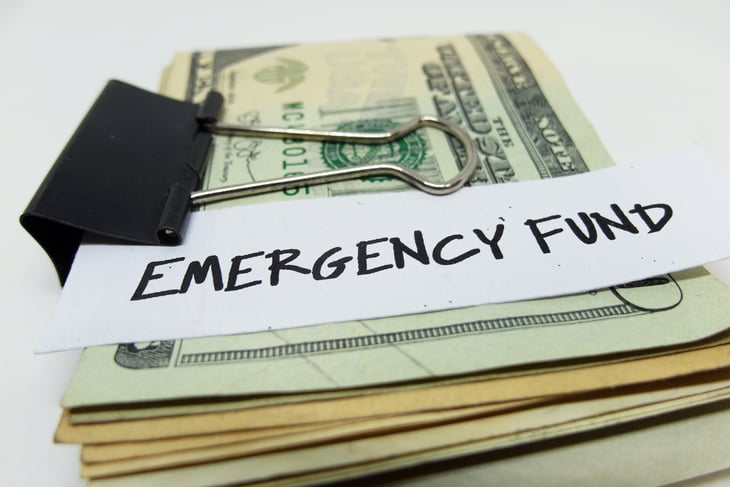
This story originally appeared on The Penny Hoarder.
Whether you’re a recent college grad or you attended college years ago, there’s a good chance student loans have impacted you.
The current American student loan debt burden is $1.7 trillion.
While mortgage debt rose with inflation by about 3.2% between 2009 and 2018, student loan debt grew 102% over the same time frame.
The stats are painfully depressing. But what does all that mean if you’re an average person trying to get by and have some promise of a future?
It means you need to prioritize paying back your student loans, and fast.
Why You Should Prioritize Paying Student Loans Off Fast

Easy enough to say, right? It’d be nice to pay off student debt, buy a house and not have to stress about money every month.
But to make it happen, you need to know how to pay off student loans quickly. It’s the best way to get out from underneath their burden and get your financial life on track.
If you aren’t convinced, here are some concrete reasons:
Student loan debt — whether it’s private or federal — is almost never dischargeable in bankruptcy. In the rare cases that you can get them discharged, most bankruptcy courts will require you to prove three things in what’s known as the Brunner test:
- Based on your current income and expenses, you can’t maintain a minimal standard of living if forced to pay off student loans.
- Your inability to pay is likely to continue for a significant portion of the repayment period of the student loans.
- You have a history of trying to repay your loans.
Even if you eventually qualify for forgiveness, you’re likely to pay taxes. Unless your federal student loan debt is discharged under the Public Service Loan Forgiveness (PSLF) program, which is only available to government and nonprofit employees, you’ll have to claim the forgiveness on your taxes in the year your loans are forgiven and pay taxes on that amount as if it were income for the year.
If you’re unable to make that payment to the IRS in a lump sum, you’ll have to pay fees and interest until it’s paid in full.
The consequences of student loan debt will continue to hold you back. According to Bloomberg, student loan borrowers ages 40 to 49 are defaulting at a faster rate than those in any age group — perhaps because they’re now sending their kids to college.
And you still want to retire, right? The later you get started investing in your 401(k) and IRA, the more money you’ll need to contribute to retire.
Here are several simple strategies for paying off student loans.
1. Build an Emergency Fund

So now you see why it’s so important to pay off student loans quickly. But how do you do it? We’re here to help you figure that out with strategies to paying off student loans fast.
It may sound counterintuitive to save money instead of throwing it at your debt, but think about it: Emergencies come up all the time, especially in times when you’re low on cash.
By having a rainy day fund in a savings account, you won’t have to put those emergency expenses on a high-interest credit card or use the money you were going to put toward your student loan.
2. Take Inventory of Your Student Loan Debt

Log in to all your loan servicers’ websites, and write down the full amount you owe to each. If you’re unsure who your loan servicers are, you can use sites like Credit Sesame to run a soft credit check and see everyone you owe money to.
You’ll also need to determine if the loan is private or federal. You can check the National Student Loan Data Center for a list of your federal loans. Any loan not listed there is most likely private.
This is important, because your options for repayment will differ based on whether your loan is backed by the federal government.
3. Figure Out If You Qualify for Public Service Loan Forgiveness

Eligibility for the Public Service Loan Forgiveness (PSLF) program seems straightforward: If you’re a government or nonprofit employee, you can enroll in PSLF and have your federal student loans forgiven tax-free after 120 payments.
However, actually having your forgiveness approved can be difficult — 99% of the first applicants were rejected.
But if you’re working in an eligible field, it’s a no-brainer to at least try for it.
4. Determine Your Eligibility for Income-Driven Repayment Plans

The standard repayment term for federal student loans is 10 years, but if you have difficulty making payments, you have four main options for lowering them that take your income and expenses into account.
Note that these plans aren’t actually forgiveness programs; they’re repayment programs with a forgiveness option.
With all these plans, you must resubmit your income and family size every year to determine eligibility. Married couples will have to submit their combined income.
Use a student loan calculator to determine which of these is the best for you to enroll in. Even if you don’t want to use the forgiveness option, it is worth enrolling in one if you’re eligible as a failsafe against future financial hardship. Here are your major options:
Income-Based Repayment Plan (IBR)
If you took out your loan on or after July 1, 2014, you’ll pay 10% of your discretionary income monthly. If your loan isn’t paid off after 20 years, you can apply for forgiveness for the remainder of your loans.
Income-Contingent Repayment Plan (ICR)
An income-contingent repayment plan caps your monthly payments at 20% of your discretionary income. You must consolidate your loans before you can apply for ICR. You will be eligible for forgiveness after 25 years of payments. If you have Parent Plus loans, you will only be eligible for ICR.
Pay as You Earn (PAYE)
This program is just like IBR but for those who took out loans after Oct. 1, 2007, and before July 1, 2014. Forgiveness is available after 20 years of payments.
Revised Pay as You Earn (RPAYE)
RPAYE is like PAYE but for those who don’t qualify for any other program. Forgiveness is available after 20 years of payments for undergraduate loans and 25 years for graduate or professional school loans.
5. Lower Your Interest Rates

Federal student loans for undergraduates already have pretty low interest rates — 3% to 5% — compared with debts like credit cards and personal loans, so lowering them won’t make a huge impact. But every little bit helps, so here are a few ways to lower your rates:
Student loan refinancing. With a good credit score and steady income, you can refinance both private and federal student loans for a potentially lower interest rate.
Make sure you’re on auto-debit. Signing up for automatic payments not only ensures you make payments on time, but most servicers also will lower your rate by 0.25%.
Call your loan servicer. Private student loans tend to have higher interest rates than federal loans, but the good news is that you have more flexibility in lowering your interest rates.
Jessica Blydenburgh of St. Petersburg, Florida, made a call to her private loan servicer and was able to prove income hardship to get her interest rate dropped from 15% to 5%.
Blydenburgh’s loans were through Navient, which has an income-driven repayment plan for private loans. She had to list all of her expenses and her income to show what monthly payment she could afford. “You literally have to itemize your whole budget,” she said.
Navient determined that at her current interest rate, her payments would only apply to the interest, so the company lowered her rate to allow her monthly payment to cut into the principal.
She has to update her income and expense status every year to maintain the rate.
6. Make a Plan for Repayment

After educating yourself on your options, you’ll need a plan to pay off your loans. Think of it like plugging your destination into Google Maps: There are a few routes you can take, and one might save you a few minutes, but any route is going to go more quickly than just winging it.
We’re big fans of the debt avalanche and debt snowball methods to pay off debt.
With the debt avalanche method, you’ll start with your highest interest loan. You focus on putting extra payments toward that loan first, then once it’s paid off, you focus extra efforts on your next highest interest loan.
The debt snowball method starts with your loan with the lowest balance. You put extra toward that loan, and once it’s paid off, you focus extra efforts on your loan with the next-lowest balance.
If you’re motivated by math, you might find that the slight savings of the debt avalanche appeals to you. If you’re motivated by quick wins, the accomplishments you’ll experience early on with the debt snowball will get you through those tough first months.
7. Budget for Your Monthly Payments

While there are several types of budgets to help you allocate your money, there’s one that stands out above the rest when you’re trying to pay off debt fast: the zero-based budget.
The zero-based budget model allows you to prioritize your expenses. Using your income, you’ll go down your list of expenses, “paying” all of them until you’re at zero.
Why does it beat out the rest in the need for speed? While percentage-based budgeting methods tell you how much to pay off every month, the zero-based model puts you in charge of that decision.
You can put debt as high on your list of priorities as you want and contribute more if you have money left over.
One month you could put 30% of your take-home pay toward your loans, and the next you could put 55%.
8. Get a Side Hustle

There’s no easier way to have more money to put toward debt than by making more of it. Don’t be discouraged if you have limited spare time, are confined to your home or think you have no profitable skills to offer — trust us, there are a ton of ways to make extra money.
Some of our favorites are freelance bookkeeping, dogsitting, selling your stuff, delivering groceries and renting out a spare room.
9. Cut Your Expenses

There’s only so low you can go with cutting expenses, but by trying to cut a little more every month, you’ll gain momentum — and motivation to see how close you can get to zero.
Here are some ways people told us they saved money while they paid off their student loans.
- Val Breit used a flip phone to avoid paying for a data plan as she got rid of $42,000 in student loans.
- Cody Boorman traded in his car for a cheaper one to eliminate his car payment while he and his wife, Georgi, paid off $56,000 of student loan debt.
- Phil Risher stuck to free activities like hiking to keep him busy while tackling $30,000 of student loans.
Your budget will help you examine your spending and identify options for creatively cutting your spending.
10. Make Above-and-Beyond Payments

Making minimum payments will help you tread water, but you won’t cross the ocean with that mentality. The only way to pay off student loans early is to make payments that are above the minimum due, or make extra payments throughout the month.
If you’re using all the strategies above, this will be a natural progression. But it can be tempting to treat yourself with your newfound extra cash. A tip for sticking to extra payments is to schedule them.
If you’re increasing your regular monthly payment, schedule your larger payment for just before your regular payment, and select “advance due date” so you don’t get double-charged.
If you think “advancing” the due date might tempt you to skip a few payments, make smaller, more frequent payments every week or every other week.
And lastly, plan to send any extra money from bonuses, windfalls or tax refunds straight toward your debt.
11. Go for a Raise or Promotion

One final tip is to focus on your career as a way of increasing your income. While side gigs are great for making some quick money, your long-term wealth relies on your main gig.
That means you should ask for that raise, going for that promotion and apply for better jobs outside of your company.
Even if you don’t intend to leave your job, having an offer from another company is a powerful negotiating tool when you’re seeking better compensation and benefits.
And when you’re deciding between jobs, check to see if the company offers student loan repayment assistance. Many companies, including Fidelity, Staples, Aetna and Live Nation now offer student loan assistance as a benefit for employees.





Add a Comment
Our Policy: We welcome relevant and respectful comments in order to foster healthy and informative discussions. All other comments may be removed. Comments with links are automatically held for moderation.